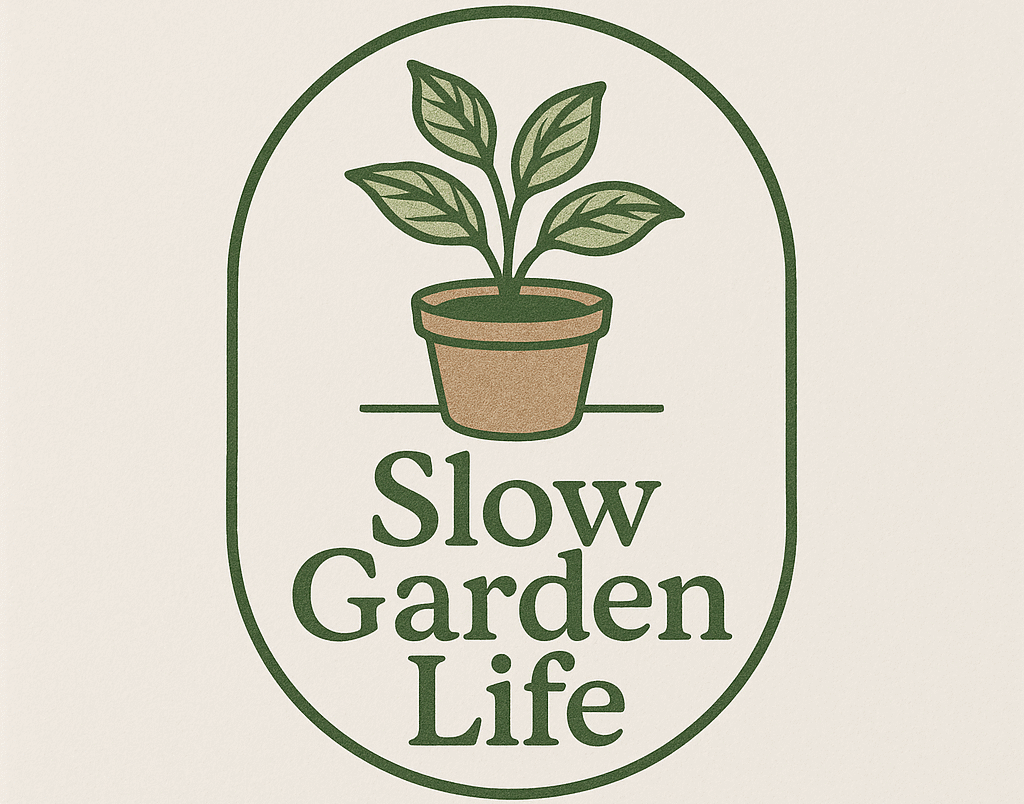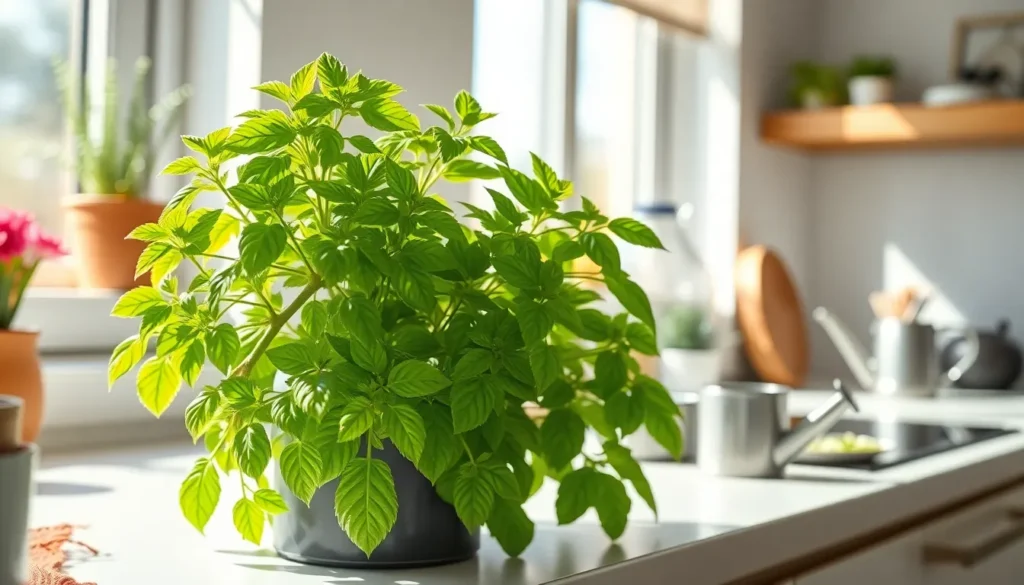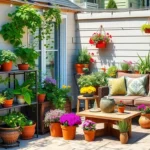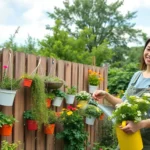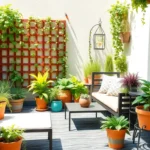Growing fresh basil indoors transforms your kitchen into an aromatic herb garden that’s available year-round. We’ve discovered that having your own indoor basil plant means you’ll never run out of this essential herb for your favorite pasta dishes, pizza toppings, or homemade pesto. There’s nothing quite like the satisfaction of snipping fresh leaves from your own thriving plant.
Indoor basil cultivation isn’t just practical—it’s surprisingly simple and rewarding. We’ve found that with the right setup and care routine, your basil plant will flourish on a sunny windowsill or under grow lights. The best part? You’ll save money while enjoying herbs that are fresher and more flavorful than anything you’ll find at the grocery store.
Whether you’re a seasoned gardener or a complete beginner, we’ll guide you through everything you need to know about successfully growing basil indoors. From selecting the perfect variety to troubleshooting common issues, you’ll soon be harvesting your own fragrant basil leaves whenever inspiration strikes in the kitchen.
Choose the Right Basil Variety for Indoor Growing
Selecting the perfect basil variety sets the foundation for your indoor herb garden success. Different basil types offer unique flavors and growing characteristics that can transform your culinary experience.
Sweet Basil for Classic Flavor
Sweet basil remains our top recommendation for indoor growing beginners. This variety delivers the classic Italian flavor profile that works perfectly in pasta sauces, caprese salads, and homemade pesto. Sweet basil plants typically reach 12-18 inches in height and produce large, aromatic leaves that release their signature scent when brushed against.
Growing sweet basil indoors requires minimal expertise since it adapts well to container conditions. We’ve found that this variety tolerates occasional watering mistakes better than other types. The plant produces white flower spikes that should be pinched off to encourage continued leaf production.
Compact Varieties Like Greek Basil
Greek basil excels in small indoor spaces due to its compact growth habit. These plants form dense, globe shaped bushes that rarely exceed 8 inches in height. Greek basil produces tiny leaves with an intense, concentrated flavor that works wonderfully in Mediterranean dishes and as a garnish.
Space efficiency makes Greek basil ideal for windowsill gardens or small apartments. We recommend this variety for kitchen countertop growing since it requires less frequent pruning than taller varieties. The small leaves pack more flavor per square inch than larger basil types.
Specialty Types Such as Thai or Purple Basil
Thai basil brings exotic flavors to your indoor garden with its distinctive licorice and spicy notes. This variety features purple stems and pointed leaves that complement Asian cuisine perfectly. Thai basil grows 12-15 inches tall and produces beautiful purple flower spikes that are edible and flavorful.
Purple basil adds visual appeal to your indoor garden while providing a unique flavor profile. These plants showcase deep purple leaves with a slightly different taste than sweet basil. Purple varieties like ‘Dark Opal’ create stunning contrast in mixed herb containers and maintain their color intensity when grown indoors with adequate light.
Specialty basils often require slightly more attention to lighting and temperature conditions than common varieties. We suggest starting with one specialty type alongside sweet basil to compare growing requirements and flavor preferences.
Select the Perfect Container for Your Indoor Basil Plant
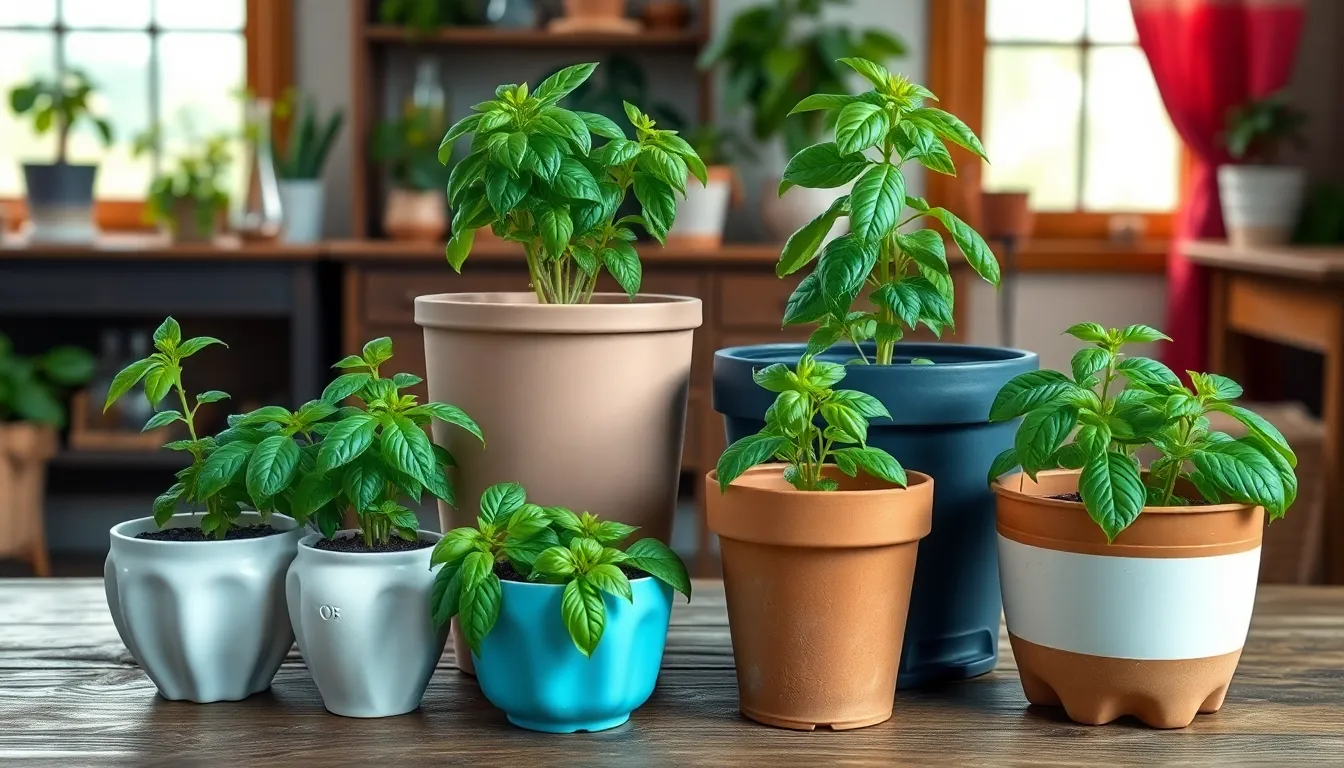
Choosing the right container sets the foundation for healthy basil growth indoors. The container you select directly impacts root development, water management, and overall plant health.
Drainage Requirements and Pot Selection
Drainage holes are absolutely essential for preventing water buildup that leads to devastating root rot. We recommend containers with multiple drainage holes at the bottom to ensure excess water can escape freely.
Potting soil with good porosity and water holding capacity supports optimal root health and prevents waterlogged conditions. Choose a well draining potting mix specifically designed for container gardening rather than garden soil.
Material options include ceramic, plastic, or terracotta containers, each offering distinct advantages for indoor basil cultivation. Terracotta pots provide excellent breathability for roots, while plastic containers retain moisture longer and weigh less for easy repositioning.
Self watering containers like EarthBox planter boxes offer convenient automated watering features that maintain consistent soil moisture. These systems reduce the guesswork in watering schedules and help prevent both overwatering and underwatering issues.
Optimal Size Considerations for Root Development
Container dimensions of at least 6 to 12 inches deep and 8 to 12 inches wide provide ideal space for basil’s extensive root system development. This size allows roots to spread naturally and supports robust plant growth throughout the growing season.
Smaller containers with 4 inches of soil depth can successfully support basil plants with proper care and attention to watering needs. We’ve found that 6 inch terracotta pots work well for single basil plants in limited space situations.
Space between multiple plants should measure 4 to 8 inches when growing several basil varieties in larger containers. This spacing prevents overcrowding and ensures each plant receives adequate light and air circulation for healthy development.
Starting basil indoors in warm conditions extends the growing season significantly compared to outdoor planting timelines. Indoor containers allow us to control temperature and environmental factors that directly impact germination success and early plant establishment.
Create Ideal Growing Conditions for Indoor Basil Success
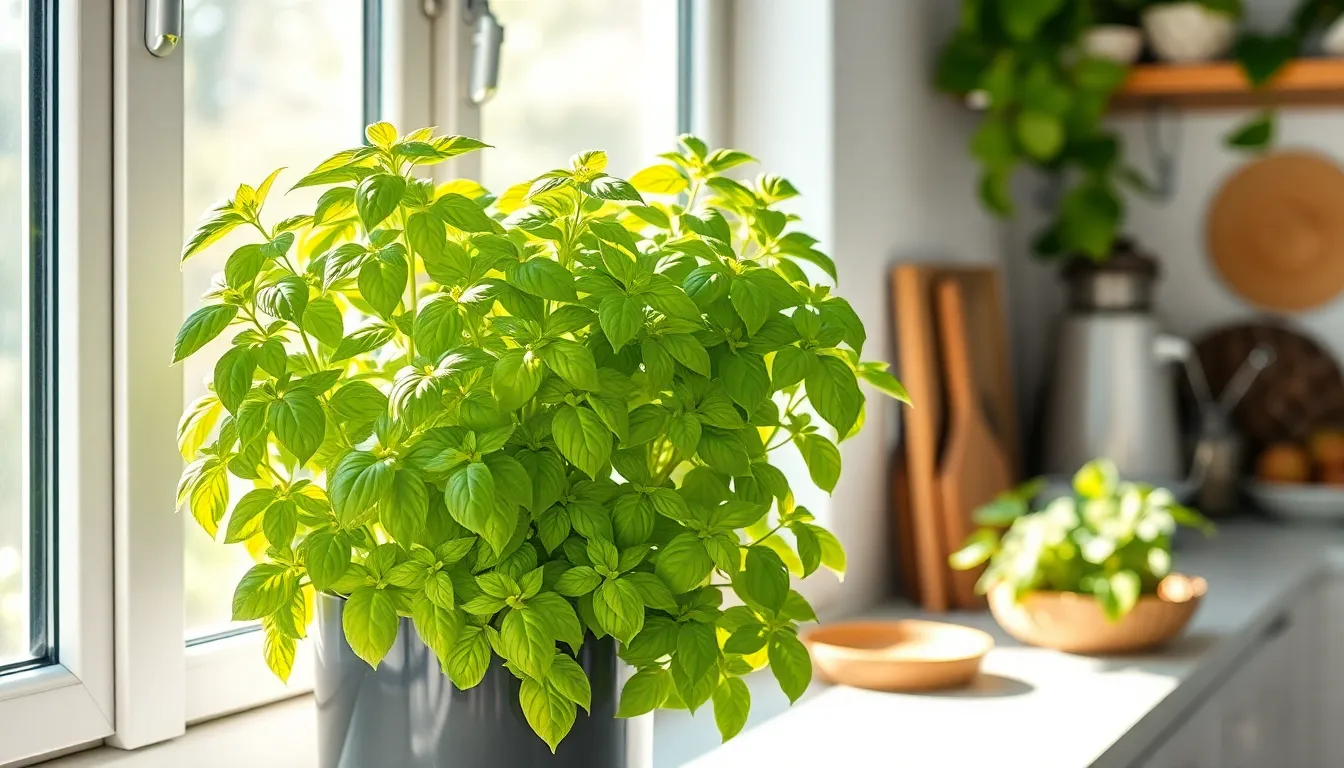
Now that you’ve selected your container and basil variety, we’ll focus on establishing the environmental conditions that make indoor basil thrive throughout the year.
Light Requirements and Window Placement
Natural light becomes your basil plant’s primary energy source for healthy growth. We recommend positioning your containers near south or west facing windows where plants receive 5-6 hours of direct sunlight daily. Window placement directly impacts leaf production and flavor intensity in your indoor basil plants.
Grow lights offer an excellent alternative when natural sunlight falls short. Fluorescent lights work effectively for indoor basil cultivation, and we suggest running them for 10 hours daily to supplement limited window light. Position these lights 6-12 inches above your plants for optimal coverage.
Light deficiency shows up quickly in basil through leggy stems and pale leaves. We’ve found that rotating containers weekly ensures even light distribution across all plant sides. Monitor your basil’s response to light changes and adjust positioning as seasons shift throughout the year.
Temperature and Humidity Control
Temperature consistency creates the foundation for successful indoor basil growing. We maintain our growing spaces between 50°F and 80°F (10°C and 27°C) for optimal plant development. Basil plants slow their growth significantly when temperatures drop below this range.
Humidity management keeps your basil leaves healthy and prevents common growing problems. We keep soil consistently moist and occasionally spritz plants in very dry indoor environments. Kitchen and bathroom locations often provide naturally higher humidity levels that benefit basil growth.
Temperature fluctuations stress basil plants and reduce their productivity. We avoid placing containers near heating vents, air conditioning units, or frequently opened doors. Room temperature stability helps maintain steady growth rates and prevents shock to your developing plants.
Air Circulation Needs
Air circulation prevents fungal diseases that commonly affect indoor basil plants. We ensure good airflow around each container by spacing plants adequately and avoiding overcrowded growing areas. Stagnant air creates perfect conditions for mold and mildew development.
Gentle air movement strengthens basil stems and promotes robust plant structure. We use small fans on low settings to create light breezes around our growing areas without causing plant stress. Natural air circulation from open windows works well during moderate weather conditions.
Poor ventilation leads to weak, susceptible plants that struggle with disease resistance. We check that air can flow freely around all sides of our basil containers. Strategic placement away from corners and tight spaces significantly improves plant health and reduces maintenance requirements.
Use Quality Soil and Proper Planting Techniques
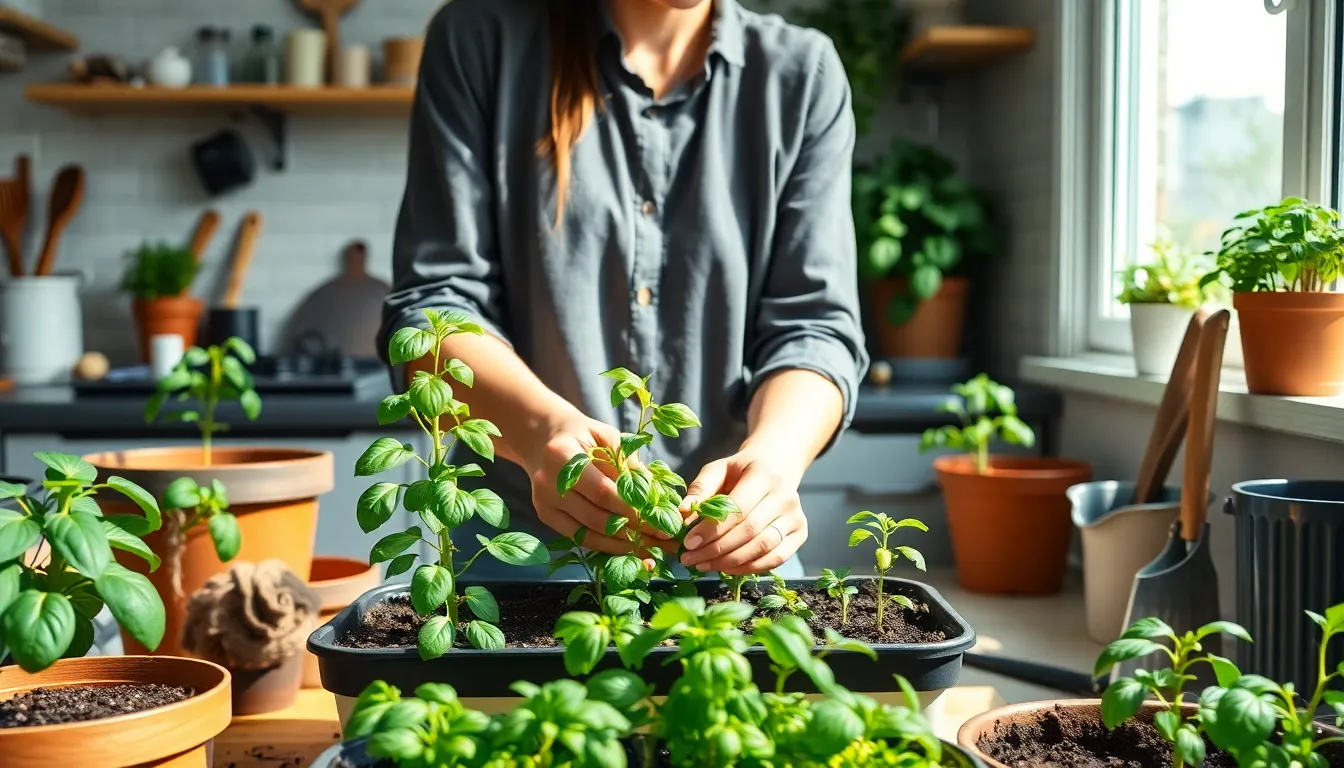
Quality soil and proper planting techniques form the foundation for thriving indoor basil plants. Getting these basics right from the start sets you up for a successful harvest throughout the growing season.
Best Soil Mix for Container Growing
Choosing the right soil mix directly impacts your basil’s root development and overall health. We recommend using a well-draining potting mix specifically designed for container growing rather than garden soil, which can become too dense in pots.
Key ingredients make all the difference in container soil performance. Peat moss provides excellent moisture retention while perlite or vermiculite ensures proper drainage to prevent waterlogging. A balanced fertilizer mixed into the soil gives your basil plants the nutrients they need for strong initial growth.
Container-exact potting mixes retain moisture effectively without creating soggy conditions that lead to root rot. These specialized blends allow air to circulate around the roots while maintaining the consistent moisture levels that basil plants crave.
Planting Depth and Spacing Guidelines
Proper planting depth ensures successful seed germination and healthy seedling development. Plant basil seeds about ¼ inch deep in your prepared potting mix, covering them with just a thin layer of soil.
Spacing between plants becomes crucial when growing multiple basil plants in larger containers or separate pots. We recommend spacing plants 12 to 16 inches apart to allow ample sunlight penetration and proper air circulation around each plant.
Gentle planting techniques protect delicate seeds and promote better germination rates. Lightly moisten your potting mix before planting, then sprinkle a few seeds on the surface and gently firm the soil after covering. Water with a gentle spray or mister to avoid disturbing the seeds.
Thinning crowded seedlings with scissors promotes healthy growth by reducing competition for nutrients and light. This practice allows the strongest seedlings to develop robust root systems and full foliage.
Master the Watering Schedule for Your Indoor Basil Plant
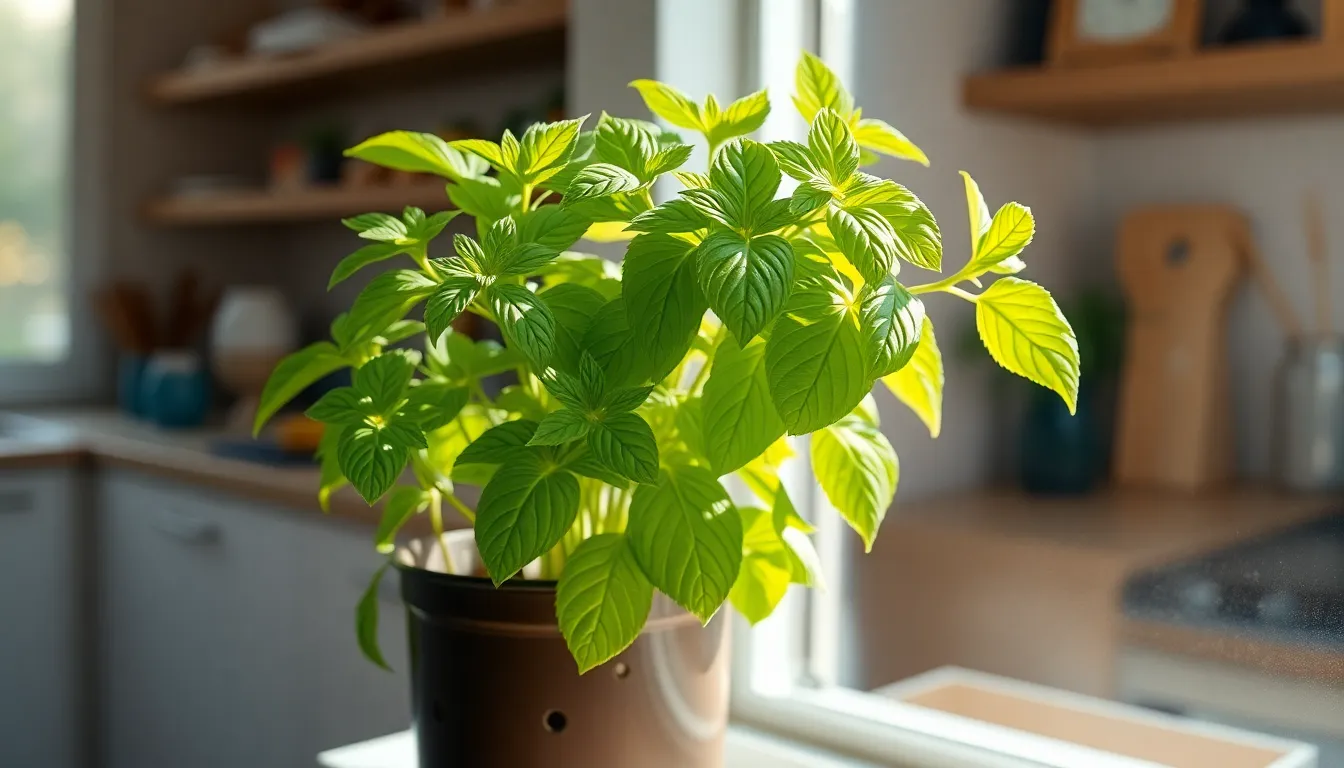
Now that we’ve established the foundation with proper soil and planting techniques, watering becomes our next critical focus for indoor basil success. Indoor basil plants typically require watering every 2 to 5 days, depending on environmental factors like light intensity, temperature, and humidity levels.
Signs of Proper Moisture Levels
Proper moisture management means maintaining consistently moist soil without creating waterlogged conditions. We can identify healthy moisture levels by observing vibrant green leaves that show steady growth patterns and remain free from wilting or yellowing.
The soil should feel moist to the touch when we check the top 1-2 inches, but it shouldn’t be soggy or have standing water. Basil roots thrive in this balanced moisture environment where they can access water without becoming saturated.
Misting the leaves occasionally helps supplement our plant’s moisture needs since basil absorbs some humidity through its foliage. This technique works particularly well in dry indoor environments where humidity levels drop below optimal ranges.
Avoiding Overwatering and Root Rot
Overwatering poses one of the most serious threats to indoor basil plants, often leading to root rot and stem mildew that can kill the entire plant. We must ensure our containers have adequate drainage holes to prevent water from accumulating at the bottom.
After each watering session, excess water should drain away completely, and we should never allow pots to sit in standing water for extended periods. Soggy soil creates the perfect breeding ground for fungal diseases that attack basil’s delicate root system.
| Watering Aspect | Recommendation |
|---|---|
| Frequency | Every 2-5 days based on environment |
| Soil Check | Test top 1-2 inches before watering |
| Drainage | Use pots with multiple holes |
| Water Level | Keep moist but never waterlogged |
| Application Method | Water at soil level, avoid leaves |
We should always check soil moisture before watering by inserting our finger into the top layer of soil. Water deeply around the plant base while avoiding the leaves, as wet foliage increases the risk of fungal infections that can spread throughout our basil plants.
Provide Adequate Nutrition Through Fertilizing
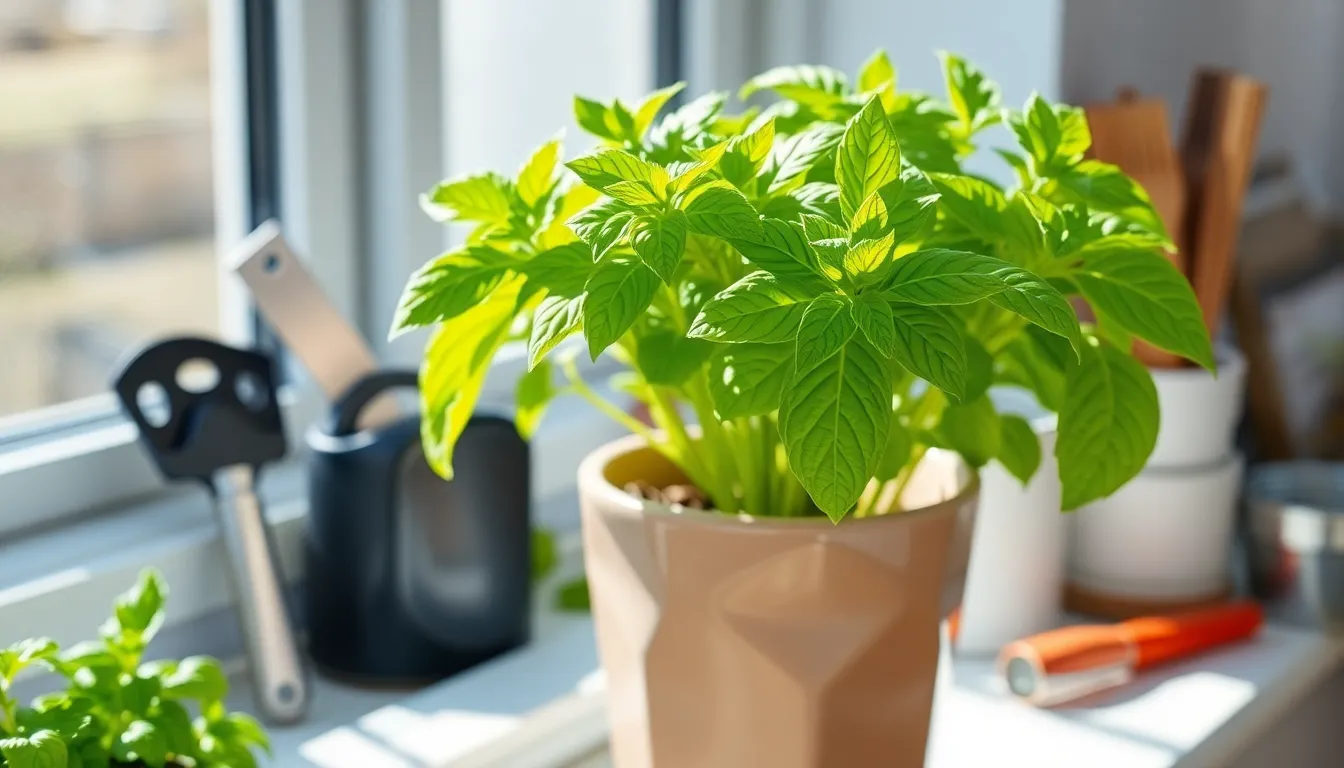
Indoor basil plants thrive when we provide them with proper nutrition through regular fertilization. Balanced or high nitrogen water-soluble fertilizers work best for promoting healthy foliage growth while maintaining the essential oils that give basil its distinctive flavor.
Organic Fertilizer Options
Leafy Green and Herb Food offers an excellent organic solution with its 5-3-3 NPK ratio specifically designed for herb cultivation. This balanced formula promotes vigorous foliage development without compromising the plant’s natural flavor compounds. Burpee produces high quality organic fertilizers that we can trust for our indoor herb gardens.
Natural compost tea provides another effective organic approach that slowly releases nutrients into the soil. Worm castings mixed into potting soil create a nutrient rich foundation for sustained growth. Fish emulsion fertilizers deliver quick acting nutrition that basil plants readily absorb through their root systems.
Feeding Frequency and Application Methods
Schedule your fertilizing every four to six weeks during the active growing season for optimal plant health. Container grown basil requires more frequent feeding than outdoor plants due to limited soil volume and faster nutrient depletion. Growing months typically span from spring through early fall when plants actively produce new leaves.
Apply diluted water-soluble fertilizer directly to moist soil rather than dry conditions to enhance nutrient uptake. Check that the top layer feels slightly damp before feeding to prevent root burn from concentrated nutrients. Follow package instructions carefully since overfertilizing can reduce essential oil production and diminish flavor quality.
Water thoroughly after application to distribute nutrients evenly throughout the root zone. Container plants benefit from gentle watering techniques that allow fertilizer to penetrate slowly without washing away. Monitor soil moisture levels regularly since basil needs approximately 1 inch of water weekly to support healthy growth and nutrient absorption.
Implement Regular Pruning and Harvesting Practices
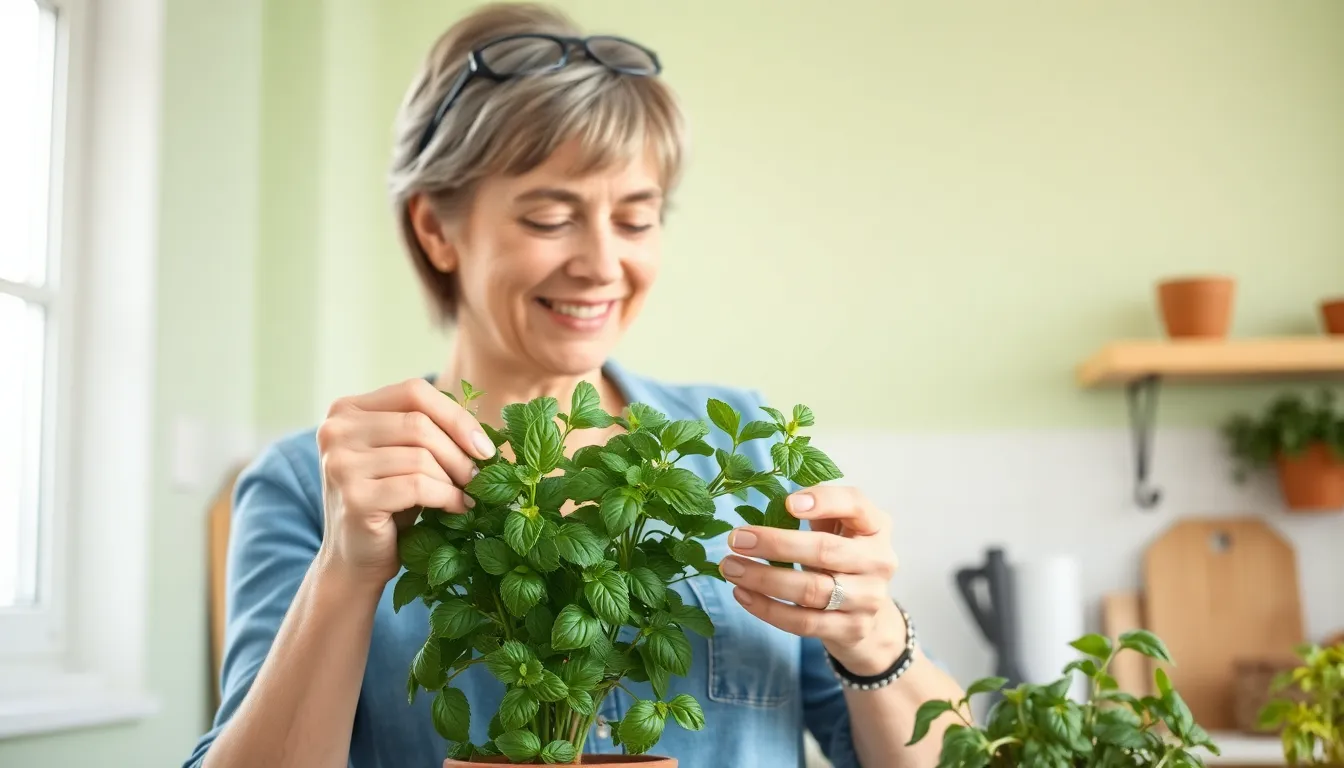
Regular pruning and harvesting techniques directly impact your indoor basil plant’s productivity and longevity. These practices encourage continuous growth while preventing your basil from flowering prematurely.
Pinching Techniques to Encourage Growth
Pinching flower buds as they form keeps your basil focused on producing flavorful leaves rather than seeds. We recommend checking your plants weekly for small flower spikes that appear at the top of stems and removing them immediately with your fingers or clean scissors.
Regular pinching of growing tips encourages your basil to develop a bushier, more compact shape. Target the newest growth at the end of each stem, pinching just above a pair of leaves to stimulate branching from that point.
Strategic pinching locations make the biggest difference in plant development. Focus on areas where you see two leaves growing opposite each other, as pinching above these nodes encourages the plant to branch into two new stems instead of one.
Timing your pinching sessions around your plant’s growth cycle maximizes effectiveness. Perform this maintenance every 7 to 10 days during active growing periods when your basil shows robust new growth.
Proper Harvesting Methods to Maintain Plant Health
Harvesting individual leaves provides the gentlest approach for ongoing basil collection. We suggest pinching off single mature leaves from the bottom of the plant first, allowing newer growth at the top to continue developing.
Stem harvesting techniques offer larger quantities while promoting healthy regrowth. Cut stems just above a node where you can see two leaves growing, ensuring your basil will branch out from that cutting point with new growth.
Continuous harvesting schedules keep your indoor basil productive throughout its growing season. Plan to harvest leaves or stems every few days once your plant reaches 6 inches in height, maintaining this regular collection pattern.
Proper cutting tools prevent damage that could invite disease or stress your plant. Use clean scissors or pinch with your fingers rather than tearing leaves, which can create ragged wounds that heal slowly.
Harvest timing considerations affect both flavor intensity and plant health. Collect basil leaves in the morning after dew has dried but before the heat of the day, when essential oils are at their peak concentration.
Prevent Common Indoor Basil Plant Problems
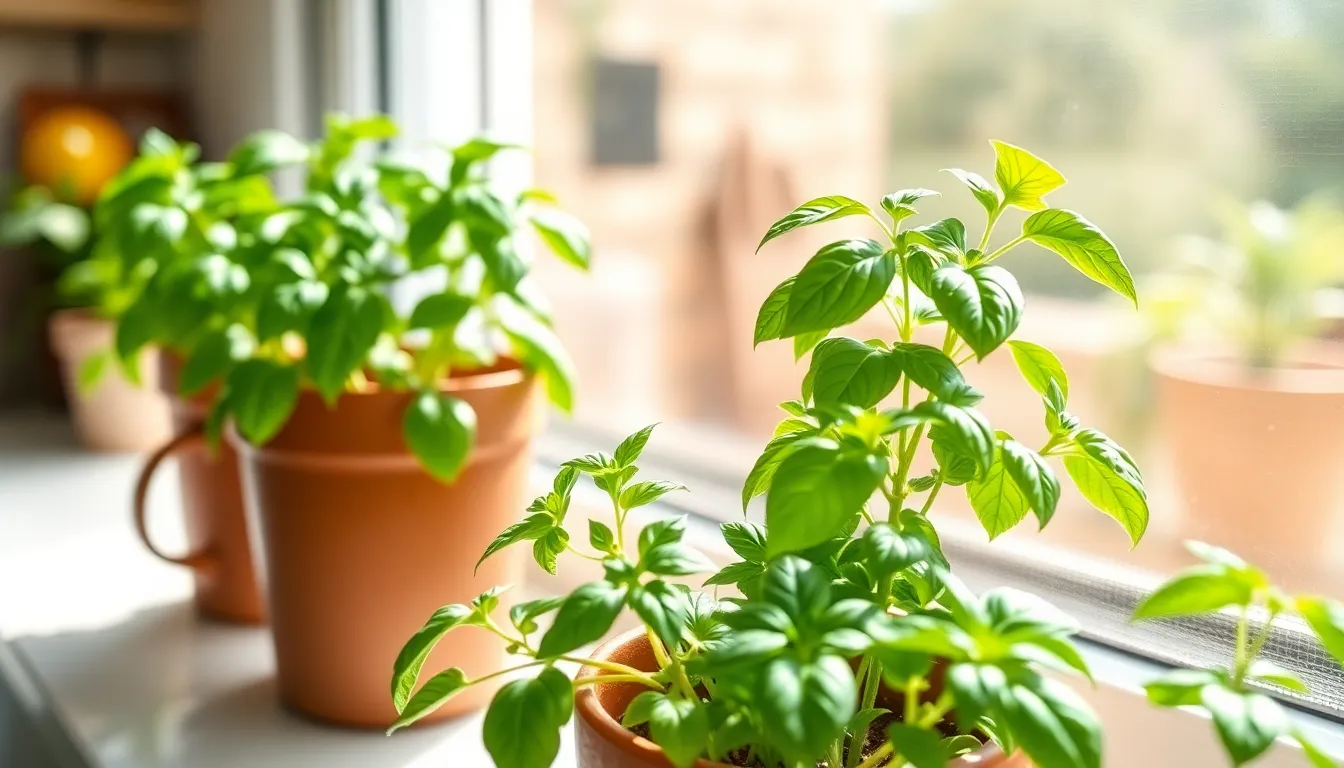
We’ve covered the fundamentals of growing healthy basil indoors, but even well-maintained plants can encounter issues that threaten their productivity and health.
Identifying and Treating Pest Issues
Aphids represent the most common pest threat to indoor basil plants. These tiny green or black insects cluster on leaf undersides and stems, causing leaves to curl and yellow. We recommend checking your plants weekly for these pests, especially around new growth areas.
Treatment becomes essential when you spot these unwelcome visitors. Apply neem oil or insecticidal soap directly to affected areas, ensuring complete coverage of leaf surfaces. Repeat applications every 5-7 days until the infestation clears completely.
Whiteflies often accompany aphid problems and appear as small white flying insects that scatter when you disturb the plant. These pests weaken basil plants by feeding on leaf juices and can quickly spread to other nearby herbs.
Control methods for whiteflies mirror aphid treatments. Use the same neem oil or insecticidal soap applications, but increase inspection frequency to twice weekly during active infestations.
Spider mites thrive in dry indoor conditions and create fine webbing on leaves while causing stippled yellow spots. We’ve found that increasing humidity around your basil plants effectively deters these microscopic pests.
Isolation becomes critical when spider mites appear. Move affected plants away from healthy ones immediately, then boost humidity levels using a pebble tray filled with water beneath the container.
Managing Fungal Diseases and Leaf Problems
Root rot develops when soil stays consistently soggy, causing roots to turn black and mushy. We can prevent this devastating condition by allowing the top inch of soil to dry between waterings, typically every 1-2 days depending on your indoor conditions.
Recovery requires immediate action when root rot appears. Transplant your basil into fresh, well-draining potting soil after removing all affected root portions with sterilized scissors.
Leaf spot manifests as brown or black circular spots on basil leaves and spreads rapidly in humid conditions with poor air circulation. Remove infected leaves immediately to prevent disease spread to healthy foliage.
Prevention strategies include improving air circulation around your plants and reducing moisture on leaf surfaces. We suggest spacing plants adequately and using a small fan to maintain gentle airflow.
Powdery mildew appears as white, powdery coating on leaf surfaces and stems, particularly in environments with high humidity and limited air movement. This fungal disease weakens plants and reduces harvest quality significantly.
Treatment involves applying appropriate fungicides while ensuring excellent air circulation around affected plants. Position your basil containers where natural air currents can reach them, or supplement with mechanical ventilation to maintain proper airflow.
Extend Your Growing Season and Plant Lifespan
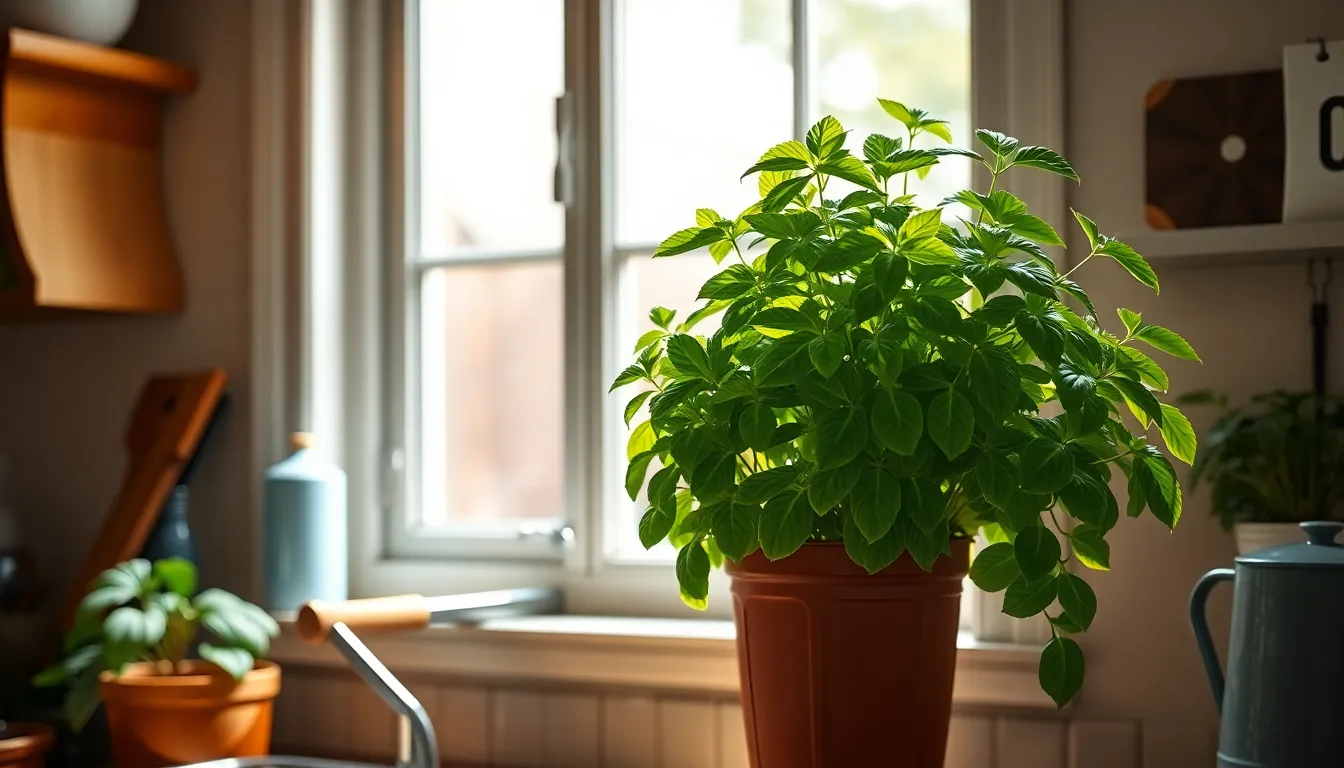
We can transform our indoor basil plants from seasonal herbs into year-round kitchen companions with proper care strategies. These techniques help us maximize both growing seasons and plant longevity for continuous fresh basil harvests.
Winter Care Strategies
Temperature management becomes critical during colder months when we need to maintain indoor conditions between 50°F and 80°F (10°C to 27°C) for optimal basil growth. Consistent temperatures within this range prevent stress and maintain healthy leaf production throughout winter.
Lighting requirements increase during shorter winter days when we must provide six to eight hours of direct sunlight or supplement with grow lights. South-facing windows work best, but grow lights ensure adequate illumination when natural light becomes insufficient.
Watering schedules need adjustment as we monitor soil moisture more carefully during winter months. Keep soil moist but not soggy since basil remains prone to root rot, checking every 1-2 days and watering when the top inch feels dry.
Fertilization routines continue with balanced NPK fertilizer (1-1-1) applied once monthly during peak growth periods. Winter applications support steady growth even when outdoor conditions would normally halt development.
Container maintenance requires checking drainage systems regularly to prevent waterlogged soil conditions. Proper drainage becomes even more important during winter when evaporation rates decrease.
Succession Planting for Continuous Harvest
Planting schedules work best when we start new basil seeds every 1-2 weeks to ensure continuous supply throughout the growing season. This staggered approach provides fresh plants as older ones decline or get harvested heavily.
Harvesting techniques focus on pinching or cutting flower buds immediately to encourage leaf growth and prevent seed formation. Regular removal of flowering stems redirects energy into producing more flavorful leaves for our kitchen use.
Pruning practices maintain plant shape and promote new growth when we regularly trim stems above leaf nodes. Strategic pruning encourages bushier growth patterns and extends individual plant productivity.
Pest monitoring becomes essential as we regularly inspect plants for aphids and spider mites, treating promptly when found. Indoor environments can harbor pests that multiply quickly without proper surveillance and intervention.
Maximize Your Harvest Through Proper Storage Methods
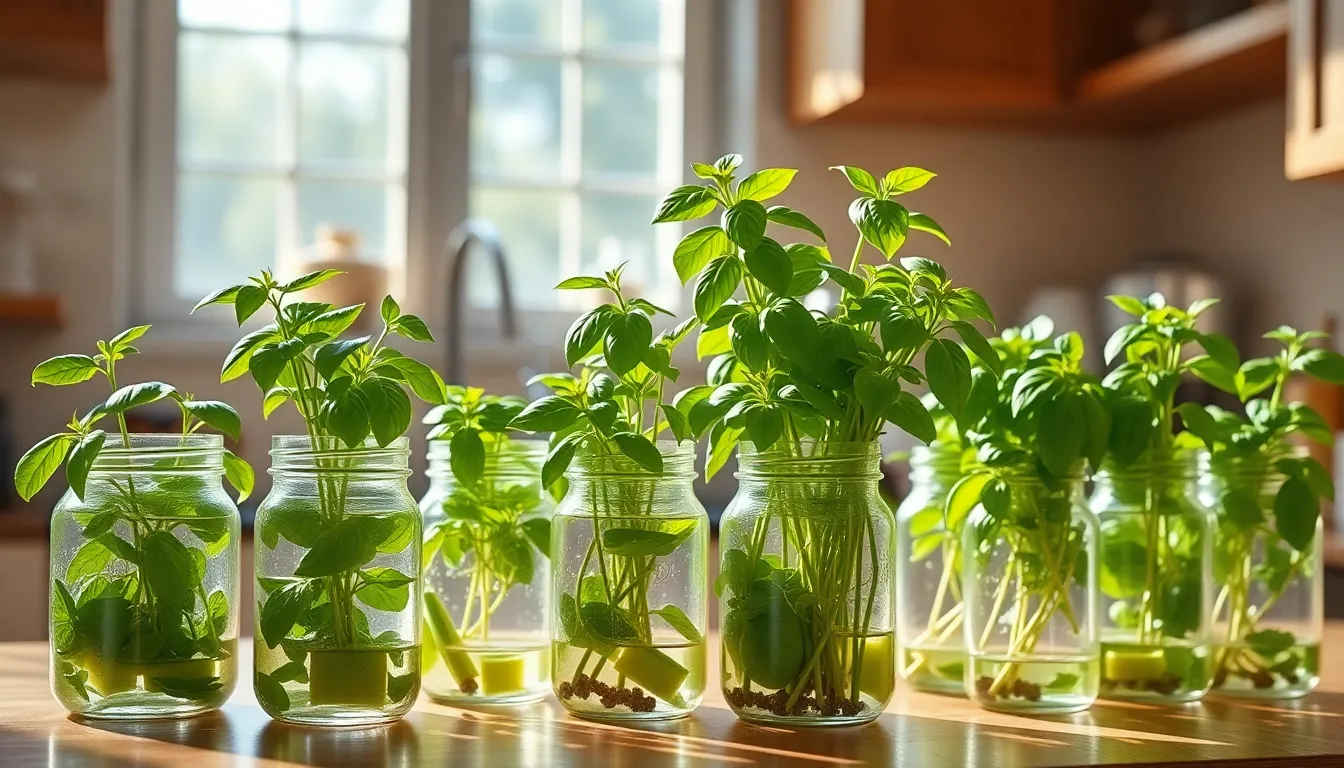
Once we’ve mastered growing indoor basil, preserving our harvest becomes essential for year-round enjoyment. Proper storage methods can extend the life of our fresh basil from days to months.
Fresh Basil Preservation Techniques
Water storage offers the most effective method for keeping basil fresh for immediate use. We simply trim the basil stems and place them in a jar or vase filled with water, similar to caring for fresh flowers. Changing the water every few days prevents bacterial growth and maintains optimal freshness.
Moist environment storage works exceptionally well for extending basil life in our kitchens. We create humidity around the basil using a plastic bag with small holes for air circulation. This technique mimics the plant’s natural growing conditions while preventing moisture buildup that could cause decay.
Refrigerator storage combines the best of both methods for longer preservation periods. We place the basil stems in a vase with water, cover them loosely with a bag, and store the arrangement in our refrigerator. Unlike countertop storage, this method requires no water changes, though we should remove any fallen leaves to maintain freshness.
Drying and Freezing Options
Traditional drying preserves basil for months but works better for herbs like rosemary and thyme than for basil. We tie basil stems in small bunches and hang them upside down in a warm, dry place away from direct sunlight. While effective for preservation, this method reduces basil’s distinctive fresh flavor profile.
Ice cube freezing maintains more of basil’s original taste and aroma throughout the year. We chop fresh basil leaves and place them in ice cube trays filled with water, creating convenient portions for soups, sauces, and other recipes. These frozen cubes dissolve easily into hot dishes while releasing concentrated basil flavor.
Olive oil preservation creates flavorful additions that enhance our cooking throughout winter months. We mix chopped basil with olive oil before freezing the mixture in ice cube trays. This method not only preserves the herb but also creates ready-to-use flavor enhancers for pasta dishes, pizza, and Mediterranean recipes.
Conclusion
Growing basil indoors transforms your kitchen into a year-round herb garden that’s both rewarding and practical. With the right container, quality soil, and consistent care, you’ll enjoy fresh aromatic leaves whenever your recipes call for them.
The key to success lies in understanding your plant’s basic needs: adequate light, proper watering, and regular harvesting. These simple practices ensure your basil plants stay healthy and productive throughout their growing cycle.
Whether you’re a seasoned gardener or just starting out, indoor basil cultivation offers an accessible way to elevate your cooking while connecting with your food. Start with one variety, master the basics, and expand your herb garden as your confidence grows.
Frequently Asked Questions
What is the best basil variety for beginners to grow indoors?
Sweet basil is the ideal choice for beginners due to its classic Italian flavor and excellent adaptability to container conditions. It’s forgiving and grows well in most indoor environments. Once you master sweet basil, you can experiment with specialty varieties like Thai basil or purple basil for unique flavors and visual appeal.
What size container do I need for growing basil indoors?
Choose a container that’s at least 6-12 inches deep and 8-12 inches wide for optimal root development. The container must have multiple drainage holes to prevent root rot. While smaller containers can work with proper care, larger ones provide better growing conditions and require less frequent watering.
How much light does indoor basil need?
Basil requires 5-6 hours of direct sunlight daily, preferably from south or west-facing windows. If natural light is insufficient, especially during winter months, use grow lights to provide 6-8 hours of artificial lighting. Adequate light is crucial for healthy growth and strong flavor development.
How often should I water my indoor basil plants?
Water indoor basil every 2-5 days, depending on environmental conditions like temperature and humidity. Check soil moisture by inserting your finger 1-2 inches deep – water when the top inch feels dry. Maintain consistently moist soil without waterlogging, as overwatering can cause root rot.
What type of soil is best for indoor basil?
Use a well-draining potting mix specifically designed for container gardening. The ideal mix contains peat moss for moisture retention and perlite or vermiculite for drainage. Avoid garden soil, which can become compacted in containers and doesn’t provide the proper drainage basil needs.
How do I fertilize indoor basil plants?
Apply a balanced or high-nitrogen water-soluble fertilizer every 4-6 weeks during the growing season. Organic options like compost tea, worm castings, or fish emulsion work excellently. Always apply fertilizer to moist soil and water thoroughly afterward to enhance nutrient uptake and prevent root burn.
When and how should I harvest basil leaves?
Harvest basil leaves in the morning for optimal flavor. Cut stems above leaf nodes to encourage regrowth, or pick individual leaves as needed. Regular harvesting promotes bushier growth. Always use clean scissors or pinch with clean fingers to avoid damaging the plant or introducing diseases.
How do I prevent my basil from flowering?
Pinch off flower buds as soon as they appear to keep the plant focused on leaf production. Flowering causes leaves to become bitter and reduces overall plant productivity. Regular pruning and harvesting also help prevent premature flowering and maintain plant vigor.
What are common pests that affect indoor basil?
Aphids and whiteflies are the most common indoor basil pests. Treat infestations with neem oil or insecticidal soap applied according to package directions. Maintain good air circulation and avoid overwatering to prevent creating conditions that attract pests. Regular inspection helps catch problems early.
How can I extend my basil growing season indoors?
Maintain temperatures between 50°F-80°F (10°C-27°C) year-round and provide adequate lighting during shorter winter days. Practice succession planting by starting new seeds every 1-2 weeks for continuous harvests. Proper temperature management and consistent care allow you to grow basil indoors throughout the year.
What’s the best way to store harvested basil?
Store fresh basil stems in water like flowers, covering leaves with a plastic bag and refrigerating for up to a week. For longer storage, freeze leaves in ice cube trays with water or olive oil. Dried basil can be stored in airtight containers, though fresh basil provides superior flavor.
